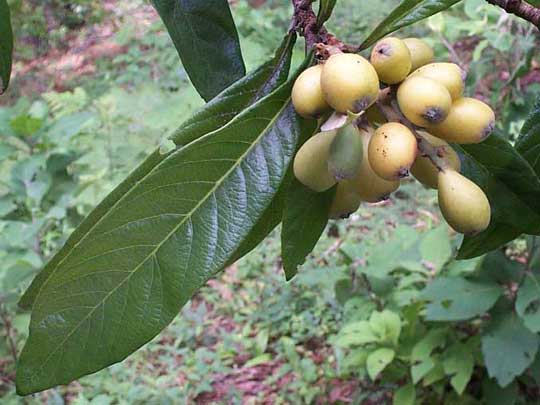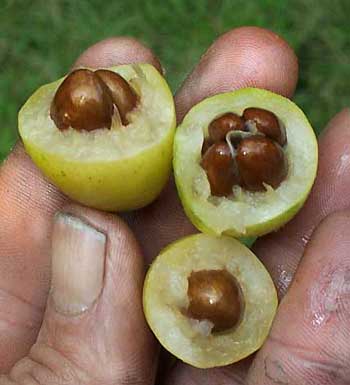Excerpts from Jim Conrad's
Naturalist Newsletter
from the November 19, 2007 Newsletter issued from Yerba Buena Clinic just outside Pueblo Nuevo Solistahuacan, Chiapas, MÉXICO
about 1740 meters in elevation, ± LAT. 17° 11' 27"N, LONG. -92° 53' 35"W
NÍSPERO
Below you can see the 1.5-inch-long fruits and 10-inch-long, leathery, evergreen leaves that are glossy above but with dense, rusty-brown, woolly hairs underneath on a commonly planted tree here:

Local folks call the 20-ft-tall tree Níspero and seem to like its succulent fruits despite their containing large, brown seeds and having pretty acidy flesh. To my taste they're OK but nothing to sneeze about. Several people have told me they like to suck the sour juice from them. I read that slightly immature fruits make good pies, the mature fruits make outstanding jams, jellies and chutneys, and that they're simply delicious poached in light syrup. Below, you can see some cut-open fruits containing one, two and four seeds.

It's a little unusual for a fruit to be so lackadaisical about its number of seeds. The plant's original inferior ovary starts out with two to five cells, or carpels, with two ovules in each carpel, but then natural abortion takes place so that hardly ever do more than five seeds form. Maybe one in ten of the fruits of the tree near my dwelling contain five seeds while maybe 80% hold either two or three.
Despite the trees being so popular here Nísperos are originally from China. However, they've been introduced throughout the world's tropics and today are commonly seen in Hawaii, southern California and southeastern Texas. In English they're called Loquats, the name a corruption of the original Cantonese name which literally meant "Reed Orange." The scientific name is ERIOBOTRYA JAPONICA and it's a member of the Rose Family.
Once you realize that the plant is a Rose-Family member it's easy to start thinking of the fruits as oversized, sour, firm-fleshed cherries.